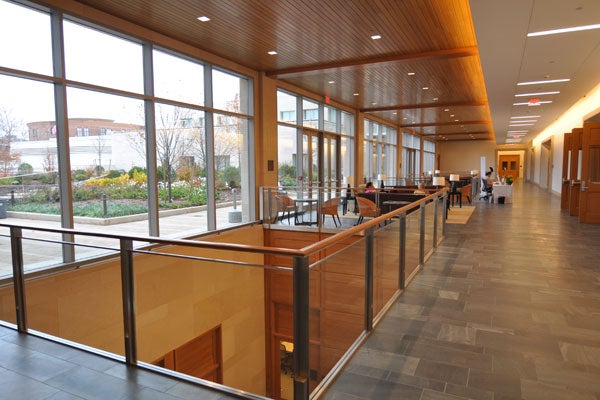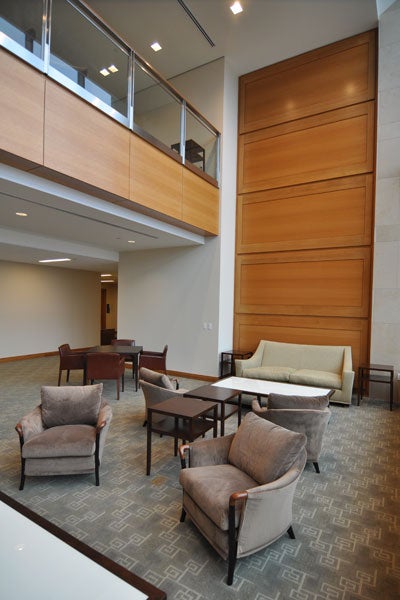Because legal education demands constant and rigorous discussion and exchange, because legal imagination springs from bridging theory and practice, and because Harvard Law School recruits and develops superb students from all over the world to pursue lives of leadership, the School commissioned—and will soon open—a new space designed precisely for these purposes.
Harvard Law School’s new Wasserstein Hall, Caspersen Student Center, and Clinical Wing building, opening January 3, 2012, features classrooms created to maximize discussion, teamwork and creativity; a wing devoted to hands-on law practice to meet local, national, and global needs; rooms devoted to student-led journals, organizations, discussion, and social life; and common spaces supporting exuberant diversity.
Designed to combine the excitement of a metropolis with the comfort of neighborhoods, the building brings together 28 clinics and 10 student practice groups devoted to fields ranging from human rights and immigration and refugee law to education law and environmental law. Proximity will enable close working relationships and productive interactions within the clinics, and between the clinics and the classrooms. Comfortable lounge and eating areas, and new spaces for student organizations and services supporting student life, will all live together under one roof. And that roof—like the building it shelters—has been built to meet gold-standard benchmarks of environmental responsibility.

Principal donors whose gifts enabled the construction of the building include the late Finn Caspersen ’66, the late Bruce Wasserstein ’70, Howard P. Milstein ’76 and Abby S. Milstein ’76, William D. Walsh ’55, Steven J. Kumble ’59, Robert Haas ’72 and the law firm of Wachtell, Lipton, Rosen & Katz.
“We are enormously grateful to these foundational supporters whose vision and commitment made this transformative building possible, and to the superb and generous alumni and friends whose aspirations and generosity are now translated into soaring spaces supporting our students and generations of students to come,” says Minow.
The 250,000-square-foot building—designed by Robert A.M. Stern Architects—composes three wings that come together around a second-story courtyard and connect seamlessly with the school’s now renovated Gropius-designed Harkness Commons. It includes the new Milstein Conference Center, a multipurpose space for large gatherings, conferences and community-wide events. Supporting the entire Harvard community is an underground garage providing spaces for 700 cars and incorporating an indoor loading dock, ensuring orderly movements in and out and quiet for the school and the neighborhood.
Wasserstein Hall


“The model of this new building is the one actually employed in virtually every law office today, where peers face each other and engage in dialogue in a mutual attempt to understand and solve complex problems,” says David Wilkins, Lester Kissel Professor of Law, Director of Harvard Law School’s Program on the Legal Profession, and Vice Dean for Global Initiatives on the Legal Profession. “With its smaller classrooms, break-spaces, and common spaces that encourage informal dialogue and socialization, this building is a perfect model for the interactive, team-based legal world where our students will build their careers.”
Wasserstein Hall will also house administrative offices for student services, including the Registrar’s Office, the Cressey Student Financial Services Suite, the Bernard Koteen Office of Public Interest Advising, the Graduate Program, and the Office of Career Services. “The new and better space, including built-in technology, will give employers from all over the world enhanced access for interviewing and recruiting Harvard Law students,” says Mark Weber, Assistant Dean for Career Services. “This will enable alumni and employers to connect with our students in more and better ways, whether through career programming and events on campus, teleconferencing, or one-on-one advising sessions.”
The Caspersen Student Center
The Caspersen Student Center, which incorporates the former Harkness Commons, will bring together some of the most important student activities: dining, informal meetings, student organizations, journals and more. The center will give students new opportunities to thrive in a centralized space that includes a new pub and the Robert B. and Candice J. Haas Lounge on the ground floor.  It will also be the new home of the Dean of Students Office.
It will also be the new home of the Dean of Students Office.
“The new journal offices are amazing, and the current 1Ls will be thrilled!” says Ellen Wheeler ’12, a 3L. “Currently, my journal has its office in the Program on Negotiation offices in Pound Hall. That space has given us access to other negotiation programming, but has isolated us from other journals. Now, being on the same hallway will encourage journals to work together, to brainstorm joint activities and share information on everything from dealing with printing issues to nitpicky questions on the Bluebook.”
Dean of Students Ellen Cosgrove adds: “The Caspersen Student Center will be a real living room for students to chat with friends, read, or prepare for class. The new pub and cafeteria will attract students for dining and socializing between classes and at the end of the day. The building will be alive and buzzing 24/7.”
The Clinical Wing

The Clinical Wing features interview rooms with state-of-the-art audio and video equipment, including recording gear with teleconferencing and video conferencing capabilities. These technologies will support students doing work across the Boston area, the nation, and around the globe.
The Clinical Wing also houses a number of the Law School’s oldest and most popular Student Practice Organizations (SPOs)—including Harvard Defenders, the Tenant Advocacy and the Prison Legal Assistance Project. These will not only be together for the first time, but they will also be in the same place as the clinics, providing 1L students in the SPOs with exposure to the clinical program and offering chances for cross-pollination between SPOs and clinics.
“We are very excited to have so many of the clinics together in one place,” says Lisa Dealy, Assistant Dean for Clinical and Pro Bono Programs. “The Clinical Wing stands as a testament to the Law School’s commitment to the local community and to providing high-quality legal services to people who most need them. HLS is one of the largest providers of free legal services in Massachusetts, and the Clinical Wing will now be one of the largest facilities offering free legal services in greater Boston.”
Green—and Gold
The Wasserstein Hall, Caspersen Student Center, Clinical Wing building is on target to receive LEED Gold Certification from the U.S. Green Building Council. Gold represents exemplary achievements in five categories of sustainability: sustainable sites, water efficiency, energy & atmosphere, materials & resources, and indoor environmental quality.
And, after an aging section of Pound Hall is dismantled next year as part of the overall site plan, the new landscape design of the area adjacent to the building will give HLS something it has never had before: a focal crossroads and quadrangle at the heart of its campus. It will also give the University a new gateway to the northwest perimeter on the Mass. Ave corridor.
A celebratory ribbon cutting is scheduled for Harvard Law School’s Spring Reunions Weekend, April 20-22, 2012.
From inception to completion, the entire project has been an example of the team-based collaborative process that Harvard Law School increasingly emphasizes in its approach to legal education—in this case, with input from students, faculty, administrators, staff, the University, the architectural team, the construction teams, and the local community. “It’s a building for the Law School, for Harvard, and for the community in which we live,” says Dean Minow. “This is a proud moment for all of us.”
